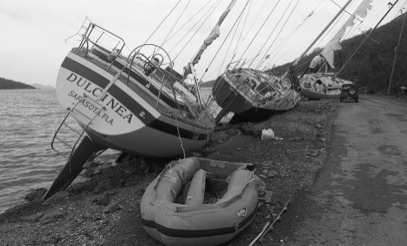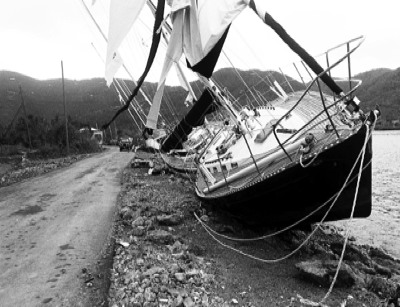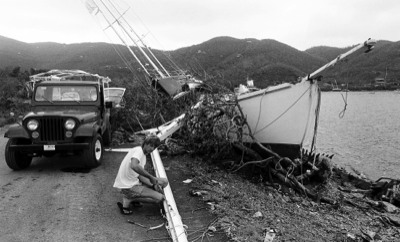Preparing for a Hurricane
Story and Photos by David H. Lyman
Originally published in Caribbean Compass, June 2013
Okay, a Hurricane Watch has been called for your part of the puddle. That means hurricane conditions are possible in a few days. Now what? Now’s the time to begin preparing the boat and yourself for what’s possibly ahead.
Have a Plan and Checklist
It’s time to drag out that Storm Plan you drew up last year, read it over, update it, keep it handy. If you don’t have a Storm Plan yet, make one now.
Every commercial airline and private pilot has print- ed checklists they use before every takeoff, prior to taxi and just prior to landing. Create a “hurricane to-do” checklist as far as possible in advance and modify it after each event. This can be very helpful as a storm approaches. It’s just a reminder to yourself of what not to forget.
Check Weather Sources
Log on to NOAA’s National Hurricane Center website (www.nhc.noaa.gov) and study the cones of probability for each hurricane and tropical storm’s track as they approach. Log on to PassageWeather.com and dial in your specific region. (www.Passageweather.com). This site gives you wind direction and speed, atmospheric pressure and wave patterns for an entire week. You can study a given hour, or animate the charts and watch the winds increase, decrease and change direction as the storm passes. [See more weather forecast sources on the following pages.]
Be aware of what’s happening in the Caribbean, the mid-Atlantic, and even in the Pacific. Some Pacific-born hurricanes sweep over Mexico, enter the western Caribbean, and head north to slam into the Gulf Coast.
Review Your Insurance
Read over your insurance policy. Talk to your broker. Alert him to your plans, listen to his advice and get his consent.
What’s your deductible, $2,000? Spend half that on preparations — a new storm anchor, line, chafe gear, a haul-out. Once you have invested in a new pennant, rode and mooring chain, you have them for years. Some insurance companies will pay for half the cost of a haul-out (and it’s also an opportunity to clean the bottom, replace the zincs and inspect the ding in the keel from the last time you hit a rock).
Initiate Your Plan
Your Storm Plan should be activated 72 hours before the storm is predicted to arrive, whether it involves hauling the boat, moving it to a hurricane hole, or doubling up on a mooring (dive on the mooring your- self, or hire a qualified mooring expert to inspect your mooring system).
Then, with two more days to prepare, you can proceed with a cool head and lots of time to do things right.
Decide: Stay On Board or Go Ashore?
This is a serious consideration, affected by a number of issues. Is the boat uninsured? Is your boat your only home? What’s the storm’s predicted intensity and wind direction? Wave action will be a serious consideration. Is your anchorage protected from both seas and wind? Does the bottom provide good holding? Have you swum down to take a look? Do you have at least three or four anchors on board? How many boats are moored or anchored nearby? How many are ill prepared for a blow? Are you confident that remaining aboard will be beneficial, or are you just planning to remain on board for the experience?
Why remain aboard? To inspect chafe gear, deploy additional anchors and fend off other boats. I’ve experienced three West Indies hurricanes aboard my 41-foot sailboat, Afaran. For two of them I had little choice, as there were few options. For the last one, Hurricane Luis (1995), I went out of my way to be aboard. But then, I skied too fast, climbed mountains that were too high, and was a Navy combat photographer in Vietnam (1967), so risk was what I lived on.
Things in my life are different now. Back then, I was single and single-handing back and forth between Maine and the Caribbean. Today, I have two kids and I’m over 70, and not as agile or strong or foolish as I was in my 30s, 40s or even 50s. Would I remain on board for a blow now? If the anchorage was well protected, and the forecast showed winds less than 80
knots, I might — if for no other reason than to be avail- able to help others. But, insurance companies tell you to prepare your boat as best you can and go ashore. It’s good advice.
Prepare Your Boat for a Blow
Remove and stow all the sails. Remove the rolling furling jib. If staying aboard and there is a chance you may have to cut loose and sail out of a cramped anchorage, leave on the reefed main (or storm trysail) and a storm jib, well wrapped and secured.
Remove all deck gear that’s not bolted down. If debris from the shore might be blown about, cover the boat’s windows with storm windows. Test the bilge pumps. Inspect the bilges to see if there is debris there that might clog the pumps.
I have mixed feelings when it comes to stripping the electronics off the boat. The GPS/chart plotter is easily removed, but the rest of the gear is more difficult to remove and re-mount.
Close and tape all ports and hatches — tight — so water has no way to get below. Wind-driven rain and spray can get through the smallest cracks. Remove air scoops (dorade vents) and replace with storm caps. Tape hatch seams with “gaffer tape” or blue masking tape that’s easier to remove and leaves no messy residue. Secure cockpit lockers with tape. Should the boat heel over, or be driven ashore on her side, this will keep water out of the inside.
Put the hatch boards in, but do not lock the boat. Leave the key in the ignition. Should your boat go adrift, someone else may come to the rescue. They will need to gain access below and run the engine to keep your boat off the rocks.
If You Remain Aboard
Are you physically ready for the tasks ahead? Are you prepared emotionally and psychologically for the experience? Do you have others who can help, or does the presence of someone else just increase your anxiety level?
Is your foul weather gear adequate? You’ll need a dive mask and snorkel as you go on deck to inspect the lines and chafe gear. You can’t see when the wind is blowing over 50 knots. Don’t believe me? Stick your head out the car window at 65 MPH in a rainstorm and tell me if you can see anything.
If you are remaining on board you’ll need extra batteries for the flashlights, a hand-held VHF radio, and supplies of food and water as the stores ashore may be closed for days following a blow. Charge the boat’s batteries. Cell phone charged?
Be prepared to remain awake through the entire storm. Tropical Storms and hurricanes only last ten to 12 hours, but they always seem to come at night. During the storm, lie down when possible to conserve energy. I doubt you’ll fall asleep, but the rest will do you good. Get lots of rest, you’ll need it. Eat and drink — water.
Anchoring Out
If planning to be at anchor for a storm, arrive at your hurricane hole a day or two ahead of it. This will hopefully give you the choice of the best spots. Inspect every element of your ground tackle: the line and chain, the anchors, the shackles and thimbles. If possible dive too inspect the bottom for hazards.
Rig the chafing gear before deploying the anchors. Set two anchors at 45 degrees, placing the storm anchor so it is used throughout the worst of the storm. If you anticipate a wind shift, set a third or fourth anchor in those directions.
Lay everything out, then set the storm anchor and back down on it, hard. Dive on it to ensure it’s well dug in. Using the dinghy, deploy the second and third anchors. Slack the first anchor line, and back down on the second and third anchors, then re-adjust all rodes so the boat rides between them. Dive again to ensure each anchor is properly set and the chain and rodes are free from anything on the bottom that could cause a problem. Re-anchor as many times as necessary. Do it right.
Back on board, adjust the chafe gear, install the snubbing line on the chain, slack the chain itself by a few feet. If the snubbing line is 30 feet, it may stretch 25 percent of its length, or eight feet. Slack the chain by that amount. Secure all the lines so that you can adjust each one separately.
Lay out extra gear. Have a spare anchor or two rigged and ready to deploy. Have spare lines, hardware and tools at the ready. Have a sharp knife handy should it be necessary to cut an anchor rode if another boat fouls your anchor line and begins dragging down on you. Have another anchor ready to drop.
Look around. Others, less experienced, will welcome your aid and advice. It’s important to you that your neighbors are well anchored or moored. Boats dragging down on others is a major cause of boats ending up on the beach.
Pay attention to details. Wire all shackles. Inspect all chain and each rode before deploying. Is your working anchor line worn? Replace it. Rope manufacturers will tell you an anchor line loses half its strength in just a few years. A dedicated storm anchor rode, one that is
stowed below, out of the sun, and used only for storms is advisable.
That Plan Again
Look at your Storm Plan and checklist. Anything missing? Anything not attended to? Have you called your insurance broker? Is your will up to date? Anyone ashore to brief?
Radio Nets
Riding out Huuircane Hugo and Luis in the Virgin Islands, I listened in to the Virgin Island Search and Rescue League (VISAR) radio net — a good bunch of savvy guys who are helpful during times like these. The radio net started hours before Hugo arrived. It was a clearinghouse of information. Boats reported in from all around the islands, giving wind speed, direction and conditions. I listened to some harrowing stories unfold, as boats began to drag, crashing into others, boats being holed and taking on water. I heard “Mayday, mayday...” from people who were trapped on a boat that was being driven up on the beach and battered by waves. At that point, there was nothing any- one could do.
The net was more helpful after the hurricanes, helping people get in touch with relatives at home. The phone system on the islands was out for days. The only way to communicate with the outside world was through helpful “hams” on their shortwave radios.
Finally
If you and your boat are forced to ride out a hurricane, use the opportunity to grow. To experience the magnitude of nature’s power provides great lessons. You’ll know how to do things better the next time. During this experience, you will also learn about your- self. It will make you stronger, more able to survive other key events in your life.
Steps for Hurricane Preparation
Well in Advance
Review your Storm Plan every spring. Bring it up to date.
Read accounts of hurricanes and Tropical Storms in books, magazines, and online.
Review your insurance policy.
Bookmark weather websites.
Hire a diver to inspect your mooring system. Discuss storm preparations with marina, yard, yacht
club managers, insurance agent and your mate. Discuss storm policy with the local harbormaster. Inspect possible hurricane holes nearby.
Inspect, replace and/or repair storm gear on board.
One Week Out
Download hurricane tracks and update daily.
Review strategy with family, crew, insurance com- pany/broker, marina.
Post checklists on board.
Top off fuel and water tanks.
Prepare storm anchoring, mooring or docking
lines and fenders.
3 Days Out
Strip the boat of sails, bimini, dodger, boom and other gear, and stow below or ashore.
On a mooring: Inspect the mooring system, install storm pennant and chafe gear, and discuss storm preparations with nearby boat owners and the harbormaster.
On your own hook: Move boat to hurricane hole and deploy anchors, attach buoys to the anchors, and if possible dive to inspect anchors and the bot- tom for anything that might foul or chafe your rode.
At the dock: Discuss storm preparations with marina personnel and fellow yachtsmen, double up lines, deploy lines to pilings abreast of the slip, double up fenders.
2 Days Out
Secure hatches and ports with tape.
Remove air vents and replace with deck plates. Secure chafe gear on all lines.
Place snubbing line on anchor chain.
1 Day Out
Monitor NOAA and NHC online storm updates.
Following the Storm
Inspect your boat for damage; check bilge, engine, plumbing systems.
Help others nearby.
Contact your insurance company (agent) with an
update on the boat’s condition.
Open up the boat to air it out.
Retrieve storm anchor gear, wash, dry and stow.
Update your Storm Plan.
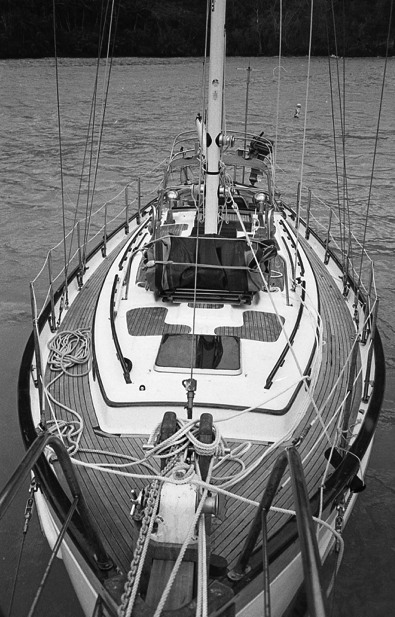
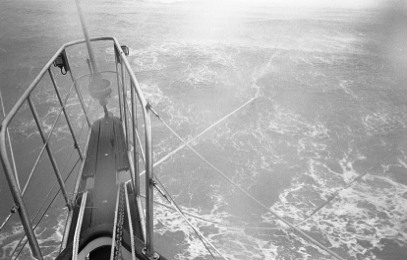
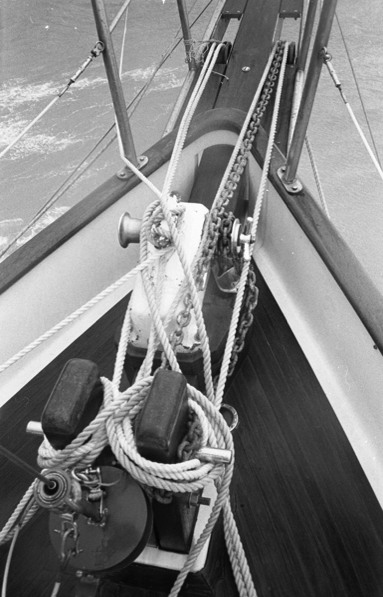
Hurricxaqne Luis, 1995 - The chaion fropmn the CQR is secured to the Sampson Post, as is the snubbing line, now slack. The twin lines to the Yachtsmen ancxhgiore tun over the port roller, witrh chaffing gewar,m and secured to the sampson post. The libe to a Danforth off top the left is slack, also leads back to the Sampson post. No lines are secured to the weindless, savde for a loose end.
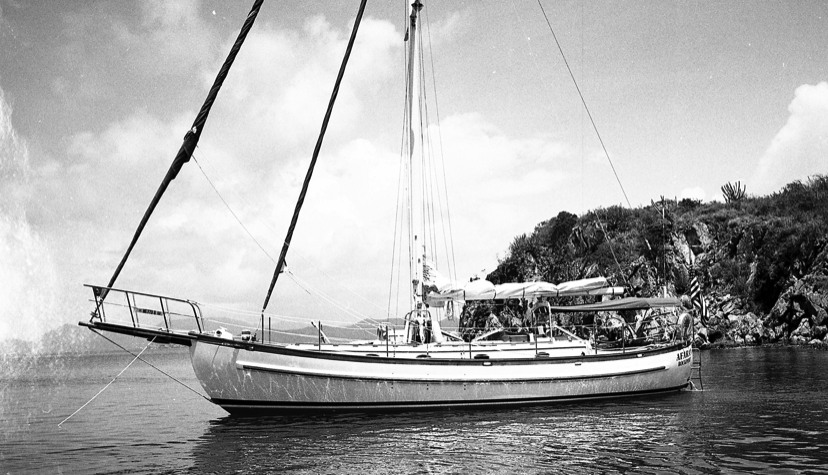
AFARAN, my Lord Nelson 41 in quieter times in the BVI.
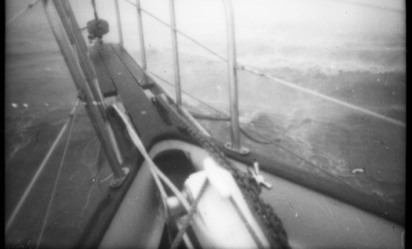
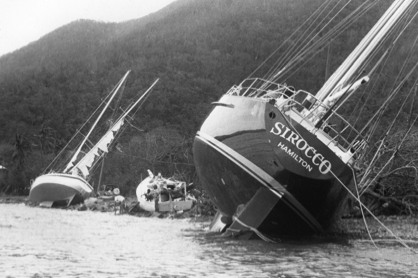
SIROCCO, you can see lines around her prop and rudder.
